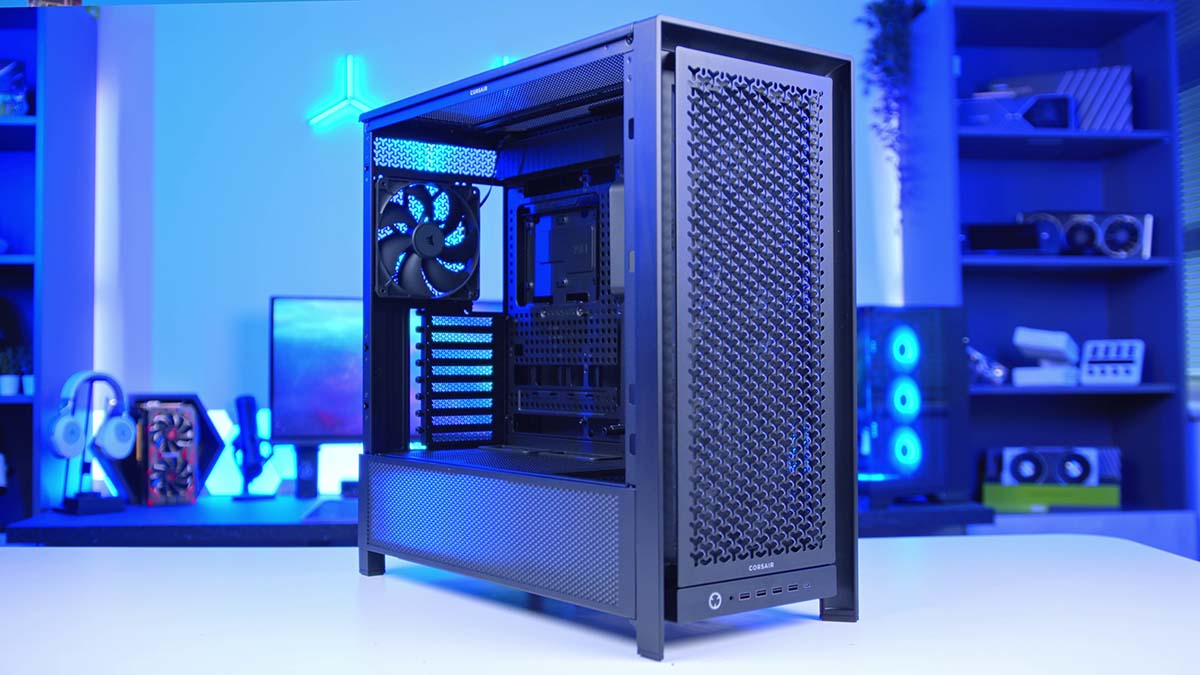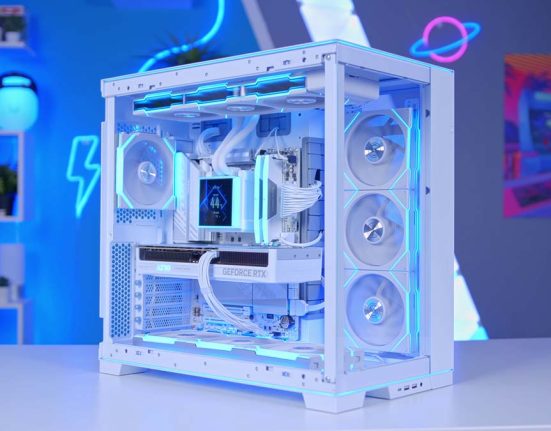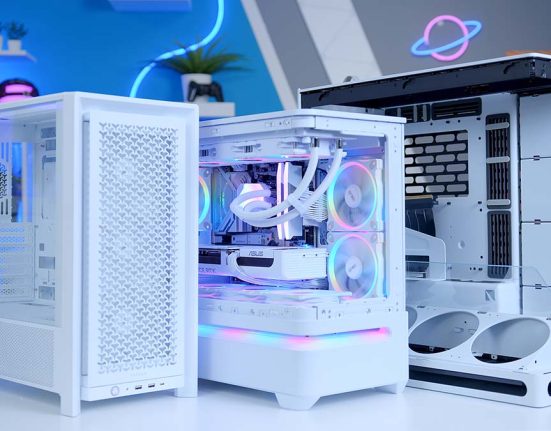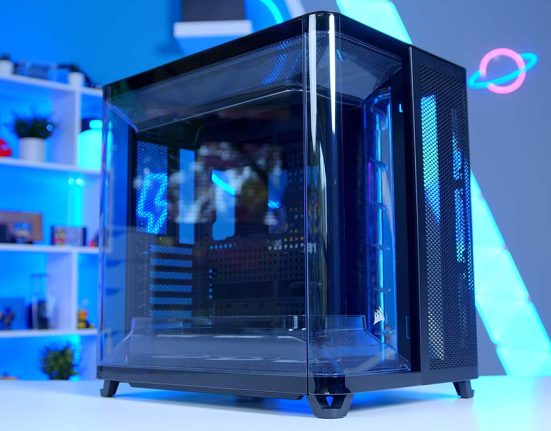In a similar fashion to the relaunch of the Corsair 4000D back in late February of 2025, the FRAME 5000D has made its way to the shelves, serving as a larger model with some nice upgrades compared to its sibling. The FRAME 5000D is, quite simply, a larger version of the FRAME 4000D, but it adds some extra features to make it worthwhile, such as support for reverse connector motherboards and a unique cable routing system that focuses on modularity.
Manufacturers are renowned for offering larger versions of popular cases, so it’s no surprise to see the FRAME 5000D on the market for builders seeking even more space to assemble an impressive PC. But with the FRAME 4000D being such a robust and versatile option, is the 5000D version more of an encumbrance than it is useful? This is something we’ve assessed with some key testing alongside a full build within this PC case.
In this review, we’ve taken a detailed look at the Corsair FRAME 5000D, analysing its design, features, and build quality to determine if it’s a solid choice compared to the 4000D and alternative cases on the market.

Did you know you can know buy our PC Builds as Prebuilts?
Specification
The Corsair FRAME 5000D, much like the 4000D, is a more traditional-looking ATX tower case with a single tempered glass side panel and a mesh front. This bigger FRAME variant remains true to form, which is great to see. Overall, the 5000D retains a remarkably similar set of specifications compared to the 4000D. The significant difference you’ll see here is the size increase, resulting in more space across the board.
Because the dimensions are larger compared to the 4000D, this chassis supports 140mm fans across all panels, except for the bottom and PSU shroud. This means you can naturally increase airflow, as the larger 140mm fans can push more air, resulting in better thermal performance. Additionally, there’s more radiator space. The top panel can now support a 420mm cooler, while the 4000D could only support a 360mm radiator at the maximum.

Clearances haven’t shifted significantly, although the FRAME 5000D is approximately 70mm wider and longer. Builders are only gaining about 20-30mm more space compared to the FRAME 4000D, resulting in more internal space. It’s great to see more room, but the resultant amount isn’t going to be a game-changer for most.
There are a few other notable points worth discussing. The FRAME 5000D accommodates reverse connector motherboards, such as MSI PROJECT ZERO, ASUS BTF and Gigabyte PROJECT STEALTH. With new reverse connector designs allegedly becoming available in 2025, those looking to pick up these boards may find the 5000D a suitable option to house a build.
| Specification | Corsair FRAME 5000D |
|---|---|
| Form Factor | Mid-Tower |
| Motherboard Support | Mini-ITX, Micro-ATX, ATX, E-ATX & Reverse Connector Boards |
| Case Dimensions (L x W x H) | 542mm x 250mm x 556mm |
| Front IO | 1 x USB 3.2 Gen2 Type-C 4 x USB 3.2 Gen1 Type-A 1 x 3.5mm Combo Jack |
| PCI-E Slots | 7 |
| Colour | Black White |
| Max Clearance | 175mm Cooler Height 450mm GPU Length 250mm PSU Length |
| Drive Support | Up to 6 x 2.5 inch Up to 2 x 3.5 inch |
| Fan Support | Front: 3 x 140mm Top: 3 x 140mm Bottom: 2 x 120mm PSU Shroud: 2 x 120mm Side: 3 x 140mm Rear: 1 x 140mm |
| Radiator Support | Front: Up to 360mm Top: Up to 420mm Rear: Up to 140mm Side: Up to 360mm |
| Pre-Installed Fans | FRAME 5000D RS: 4 x 140mm FRAME 5000D RS ARGB: 4 x 140mm ARGB |
On the front IO, gamers can leverage five USB ports, compared to the three seen on the FRAME 4000D. There are also more mounting points for 2.5-inch SATA drives if that takes your fancy. Corsair has also decided to include an extra pre-installed fan at the rear of the case, so prospective buyers will have a solid airflow configuration straight out of the box.
Last but not least is pricing. Naturally, with the increase in size and the addition of some extra features, the FRAME 5000D has seen a corresponding price increase. Ditching the zero-fan version entirely, the FRAME 5000D is available in two models: one with RGB and one without, priced at $199.99 and $189.99, respectively. I think the price jump between the 4000D and 5000D is a bit hefty. However, I think it’s warranted for the most part, the bump up to 140mm fans and the increase in internal space will be worth it for those looking to build a high-performance PC.
Corsair FRAME 5000D Design
While the specs of the FRAME 5000D differ from those of the 4000D, the design has remained largely unchanged. Corsair has retained the heavily ventilated front panel and the same simple aesthetic across the case. I don’t think this is a bad choice either, primarily because the FRAME 4000D is an excellent-looking chassis. It has a stylish, albeit simple look, ideal for a gaming setup or modern office. You can also choose the FRAME 5000D in black or white, providing options for those seeking a lighter-themed PC.

I like the contrasting look of the ventilation around the case, especially below the tempered glass panel. Not only does it offer an interesting aesthetic, but it ensures there’s ample airflow across the entire case, including within the PSU chamber.

With the added support for reverse connector motherboards, there are more cutouts around the motherboard tray. However, Corsair has also included a cutout in the top-left corner for EPS12V or CPU power cables, allowing you to easily mount a radiator while still having access to the headers.
Additionally, rubber grommets are now installed around the main cable cutouts. This provides a cleaner look to the build as any wires won’t be easily visible behind the motherboard tray.

The rear chamber of the case has remained mostly unchanged, except that it’s slightly tidier. Corsair has introduced the RapidRoute 2.0 cable management system, which we’ll discuss in the features section of this article.

Overall, I like the design. The FRAME 5000D retains all of the good qualities of the 4000D while adding more interesting aspects on top. I think if I were to be picky, the one thing I would change is the daisy-chain method of the fans. The cables on the RS140 fans at the front of the case don’t appear very clean, and I find that the only way to manage them is by tying them to the fans themselves with cable ties. It would be much easier if these were daisy-chained with one cable instead of using multiple RGB and PWM headers. Alternatively, a shroud to cover these cables would also be handy.
Building in the FRAME 5000D
Unsurprisingly, building in the FRAME 5000D is a reasonably similar experience to what we’ve seen with the FRAME 4000D. The tool-less panelling simplifies the process, allowing you to easily gain access to the internals with minimal hassle. The chassis is also highly modular, making it easy to strip the chassis down to its bare bones, which in turn makes component installation straightforward.
Getting the build assembled was quick and painless. There’s a huge amount of internal space across the board, which made installing some of the larger components, like a liquid cooling radiator and graphics card, nice and easy. Your motherboard rests on the centre standoff, so getting it screwed in again is straightforward.

The InfiniRail mounting system proved its usefulness when we were installing our liquid CPU cooler during this build. By loosening the screws at both sides, the rails can be adjusted to accommodate fans up to 160mm long. However, in this case, we only needed to shift them to the 140mm size to accommodate the 420mm radiator we installed.

When the build was being wired up, we made use of the incredibly useful RapidRoute system, which uses a pegboard-style mounting mechanism, allowing builders to change the positioning of the cable straps.

Building in the FRAME 4000D in the past, one of my criticisms was that cable management can be a bit complex and challenging to establish a clean look. However, the use of this system provides you with the freedom to create channels for wires based on your preferences, which is helpful! It is worth noting that in this particular build, we had iCUE LINK and 3-pin ARGB, making the wiring generally more challenging. However, if you decide to use the pre-installed ARGB fans and a simpler cooler that doesn’t have proprietary cabling, cable management will be much simpler.
As a final point, James noted during the build that while plugging in the CPU power headers, he had to remove the radiator. This is because there is a shroud in the way that covers the cutouts at the top. Admittedly, this appears to be a design oversight. I think it would make more sense to have the shroud added afterwards as an optional accessory. Not every builder will read the manual straight out of the gate, which means this is a relatively easy thing to overlook.
Features We Like
Unique Cable Management System
By letting builders customise the way they manage all of the wires in a PC build, it allows you to keep everything clean and tidy with minimal hassle. This is a highly unique feature that we’d like to see more of in future cases.

High-Airflow Design
The Corsair FRAME 5000D provides ample ventilation throughout to ensure thermals are kept in check. You also get four pre-installed fans in the case (three in the front and one at the rear), saving you money and offering solid airflow straight out of the box.

Features We Don’t Like
Untidy Front Fan Cables
As mentioned in the design section, one of my biggest qualms with this case is that the front fan cables don’t look tidy, and there’s no real way to hide them unless you meticulously go and tie up the headers and wires. I think Corsair would be better off including a shroud or a channel that the cables could slip into to keep them out of sight.

No Fan or RGB Hub
While I can understand why the FRAME 4000D didn’t come with a hub, the FRAME 5000D is a $200 case. I think a fan and RGB hub would significantly enhance the value proposition of the case and simplify cable management even further.

Conclusion
Corsair FRAME 5000D

Product Name: FRAME 5000D
Brand: Corsair
-
Features
-
Design
-
Versatility
-
Value For Money
Summary
The Corsair FRAME 5000D is an excellent PC case amongst the vast selection of options on the market. This case takes everything good about the FRAME 4000D and improves upon it, while also introducing a slight increase in dimensions. It offers a tremendous amount of space for varying build configurations, including support for reverse motherboard connectors. Compared to the FRAME 4000D, you’ve more front USB ports, four pre-installed 140mm fans, and more room to customise a build exactly as you’d like it. I love how innovative the design is, both from an airflow perspective and because of the unique features it offers. The customisable cable routing system is particularly impressive because it simplifies cable management, making it easier for builders to keep everything clean and tidy. In terms of weaknesses, I think the main caveat to consider here primarily is the price. The FRAME 5000D is not a cheap case by any means, and there are more affordable options on the market that may suit your preferences better than this chassis. However, if you’re looking for something around the $200 mark, I think there are very few options I’d recommend over the FRAME 5000D, as it’s an incredibly strong competitor.
Pros
✅ Unique cable management system
✅ Airflow-focused design
✅ Solid front IO options
Cons
❌ Somewhat expensive
❌ Messy front fan wires
❌ No included fan/RGB hub




![FI_[DM78] Corsair Air 5400 + 5090 Gaming PC Build](https://geekawhat.com/wp-content/uploads/2025/11/FI_DM78-Corsair-Air-5400-5090-Gaming-PC-Build-551x431.jpg)
![FI_[DP051] Antec C5 + 5070Ti Gaming PC Build](https://geekawhat.com/wp-content/uploads/2025/11/FI_DP051-Antec-C5-5070Ti-Gaming-PC-Build-551x431.jpg)


![FI_[DM76] HAVN BF360 5090 Build](https://geekawhat.com/wp-content/uploads/2025/10/FI_DM76-HAVN-BF360-5090-Build-1-551x431.jpg)